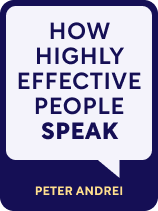

This article is an excerpt from the Shortform book guide to "How Highly Effective People Speak" by Peter Andrei. Shortform has the world's best summaries and analyses of books you should be reading.
Like this article? Sign up for a free trial here.
What’s a great way to make a good first impression? How might you connect with people better if you knew what they care about?
Peter D. Andrei says the key to rhetoric is understanding how people think. He discusses several cognitive biases in the context of persuasive communication. One of these is the halo effect, and he explains how to use the halo effect to your advantage.
Continue reading to learn Andrei’s strategies and see how they might help you communicate more persuasively.
The Halo Effect
The halo effect is the tendency for people to base their overall impression of a person on one observed quality, and Andrei argues you can use this bias to make yourself appear competent and trustworthy to your audience. Essentially, the halo effect is the bias that tells us that good first impressions do matter. Andrei explains how to use the halo effect to your advantage by creating an influential environment, demonstrating consequences early, and establishing common values.
The halo effect is the result of a combination of other cognitive biases, including the primacy effect, attribution substitution, and confirmation bias. When you notice an initial positive quality in a person (primacy effect), you’ll attribute a host of other positive qualities to that person (attribute substitution), and then see small signs that point to those positive qualities as confirmation of your beliefs (confirmation bias).
(Shortform note: Psychologists say that the halo effect comes from two things. Like most biases, the halo effect is a mental shortcut that helps us make easier, quicker judgments. It also helps us avoid cognitive dissonance, or inconsistencies in our beliefs and actions. It’s much easier to say someone or something is all good or all bad than to understand the more nuanced reality, and it can make us very uncomfortable when our original perception is challenged.)
Here are a few of Andrei’s strategies that use the halo effect:
Create an Influential Environment
When it comes to first impressions, context matters. By creating an impressive environment, you can make a good first impression on an audience before you enter a room or utter a word. Book your speech at the most luxurious place you can afford. Give your work presentation in the best conference room available. Make the space you’re communicating in as presentable as possible, and your audience will think you’re a competent and reliable speaker before you begin. If communicating in written form, take the time to make the aesthetic as visually pleasing as you can.
| Environment and Situational Status In Pitch Anything, Oren Klaff explains why creating an influential environment matters. He argues that appearance is a crucial element of perceived status (how others measure your worth and popularity), and your status has a major impact on the success of your speech or presentation. If you have a low perceived status in the eyes of your audience, you have little chance of persuading or influencing them. Klaff differentiates between two types of status: global and situational. Global is more permanent, indicated by your position or reputation. Situational status can change from moment to moment, however, and might be affected by the environment. If you’re speaking in an impressively decorated room, you might have a higher situational status and thus be more likely to have your audience’s respect and attention. |
Demonstrate Consequences Early
At the outset, make clear why your speech matters and the impact it will have on your audience’s lives. If your audience knows early on that what you’re about to say is important, they’ll see you as an important figure, and you’ll command their attention and respect. Conversely, if you don’t show why your speech matters early on, they’ll think you’re unimportant and boring, and you’ll have much less of an impact. Psychological studies confirm that demonstrating consequences early is an effective way to make your communication more compelling and persuasive.
A specific way to do this is to present a positive conditional statement, then a negative conditional statement, then proof—”If you do this, [positive effect] will happen. If you don’t, [negative effect] will occur. This has been shown time and time again by [proof].” The previous paragraph illustrates this technique in action.
(Shortform note: In Get to the Point!, Joel Schwartzberg argues that a common struggle in persuasive communication is the inability to get a clear point across. In order to demonstrate why your speech matters, you need to make sure the point you’re trying to make is as clear and precise as possible. To do this, answer the question, “So what?” after you’ve come up with your initial idea or argument. For example, if your argument is that social media are shortening the attention spans of teenagers, provide the “so what” right after—this will have a major impact on their mental health and productivity in the future. Andrei’s advice to immediately state the consequences of following your recommendation is a practical way to show the “so what.”)
Establish Common Values
Establishing common values with your audience early in your communication is one of the most powerful uses of the halo effect, according to Andrei. When you show you share the same values or beliefs as your audience, you establish a connection. They’ll like you immediately, and this feeling will help the rest of your speech resonate with them even more powerfully.
To employ this strategy, you either need to know your audience and the common values they’d likely share, or use a universally shared value or belief. For example, if you’re writing a grant for an educational program, you could start by sharing your belief that education is one of the most beneficial uses of public funds. If you’re making a speech that you hope appeals to the entire political spectrum, you might start talking about the values of peace and freedom.
(Shortform note: You might also use the halo effect as a way to establish common values without explicitly stating them. In Thank You For Arguing, Jay Heinrichs argues that establishing common values is a form of ethos, or ethical appeal. When you show that you have the same values as the audience, they’ll find you virtuous and trustworthy. But Heinrichs also points out that audiences will find you trustworthy if you look or dress like your audience, and share a story about an experience they’ve also had, you’ll seem virtuous to them, and they might even assume you share their values.)

———End of Preview———
Like what you just read? Read the rest of the world's best book summary and analysis of Peter Andrei's "How Highly Effective People Speak" at Shortform.
Here's what you'll find in our full How Highly Effective People Speak summary:
- That persuasive speech is a complex craft that can be studied and learned
- How to take advantage of cognitive biases to be more persuasive
- Why trying to manipulate others' thoughts isn't inherently immoral






